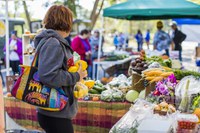Farmers Markets Can Accept SNAP Benefits
(Click the image below to view a high-resolution image that can be downloaded)
Farmers markets and farm stands have the opportunity to increase access to fresh, local food for all community members by becoming an authorized retailer for the Supplemental Nutrition Assistance Program (SNAP).
SNAP is a U.S. Department of Agriculture (USDA) program that provides economic benefits on a monthly basis to individuals and families with limited resources.
Farmers markets and farm stands have to take a few steps to be able to accept SNAP benefits. They must:
- Create an account with the USDA at https://www.eauth.usda.gov/eauth/b/usda/registration.
- Complete the online application within 30 days of starting the application at https://www.fns.usda.gov/snap/supplemental-nutrition-assistance-program-snap. To complete this application, farmers markets or farm stands will need a personal Social Security number or government employer identification number (EIN), photo ID, address of the market or stand and (anticipated) sales data.
- Submit supporting documents.
- Check the application status.
The Food and Nutrition Service takes 30 to 45 days to approve or deny applications. A farmers market or farm stand can begin accepting SNAP at any point in the season after approval.
”Be sure to include training for market staff, vendors and customers prior to rolling out the SNAP program,” advises Jan Stankiewicz, North Dakota State University Extension community health and nutrition specialist.
“While there can be great economic benefits to individuals and communities if farmers markets accept SNAP, it is important to note that there are costs associated with the program,” Stankiewicz adds. “These include transaction fees (which can vary between 10 and 15 cents per transaction, depending on merchant services and agreements), equipment rental/lease fees if the equipment is not purchased, monthly service fees for a merchant account and any wireless connection fees.”
Choosing the appropriate equipment to process SNAP transactions is an important consideration, she notes. Farmers markets and farm stands have several options to choose from, and the best option will depend on the market’s needs.
Farmers markets and farm stands should start with wireless equipment options, then gather information from fellow markets and merchant services providers to determine which piece of equipment will work best.
The North Dakota Department of Human Services (NDDHS) can assist with off-setting some or all of the cost of the SNAP electronic benefits transfer (EBT) card reading machine. Funding is available to reimburse a limited number of new markets for the cost of the equipment, up to $1,200. Depending on the needs of the market, the NDDHS also can provide signage and a banner to promote and inform customers of SNAP acceptance.
A new option for equipment support soon will be available through a cooperative agreement with the National Association of Farmers Market Nutrition Programs called The App. The App is a SNAP mobile transaction processing application. It is free of cost for one year. It enables farmers markets to accept SNAP EBT payments on their own smart device.
“Successful SNAP programs at farmers markets and farm stands will rely on marketing and promotion, strong community partnerships, time and consistency,” Stankiewicz says.
In North Dakota, the Department of Human Services (DHS) distributes approximately $7 million in SNAP benefits to 27,200 households on a monthly basis via an EBT card. In April 2020, the DHS reported a 34% increase in SNAP applications as a result of a loss of income and/or COVID-19.
In fiscal year 2019, $4,635 in SNAP dollars were spent at 11 farmers market across the state, which is significantly less than 1% of SNAP distributions.
“As more and more farmers markets accept SNAP, there is an overwhelming opportunity to bridge the gap in SNAP benefits being spent on local foods,” Stankiewicz says. “Furthermore, every $1 in SNAP benefits can generate $1.70 in economic activity, and that benefit can increase exponentially when applying to the local food economy.”
For questions and technical assistance, contact Stankiewicz at 701-328-9719 or jan.stankiewicz@ndsu.edu.
NDSU Agriculture Communication - June 2, 2020
| Source: | Jan Stankiewicz, 701-328-9719, jan.stankiewicz@ndsu.edu |
|---|---|
| Editor: | Ellen Crawford, 701-231-5391, ellen.crawford@ndsu.edu |


